



As a variation, however, we can remove the "top" triangle, leaving two scaled triangles with the same orientation as the original and one scaled triangle rotated by 180°.

The IFS for this fractal is given by the following three functions corresponding to the three triangles taken from left to right.
|
\({f_1}({\bf{x}}) = \left[ {\begin{array}{*{20}{c}}
{1/2} & 0 \\
0 & {1/2} \\
\end{array}} \right]{\bf{x}}\) |
scale by 1/2 |
|
\({f_2}({\bf{x}}) = \left[ {\begin{array}{*{20}{c}}
{-1/2} & 0 \\
0 & {-1/2} \\
\end{array}} \right]{\bf{x}} + \left[ {\begin{array}{*{20}{c}}
{3/4} \\
{\sqrt{3}/4} \\
\end{array}} \right]\) |
scale by 1/2, rotate by 180° |
| \({f_3}({\bf{x}}) = \left[ {\begin{array}{*{20}{c}} {1/2} & 0 \\ 0 & {1/2} \\ \end{array}} \right]{\bf{x}} + \left[ {\begin{array}{*{20}{c}} {1/2} \\ 0 \\ \end{array}} \right]\) | scale by 1/2 |

Each transformation has been labeled by a number from 1 to 6. We can apply any of these transformations to the triangles in the construction above (where the "top" triangle has been removed) and the three remaining triangles will still fit together as before. Only the orientation of each triangle may be different. Repeating the construction recursively on the remaining three triangles will produce a fractal that we might call a "triangle fractal" because it will live inside the original equilateral triangle. We can identify each pattern in the design for the fractal by the three digits associated with the transformations applied to the three triangles, with the digits read from left to right (but remember that the middle triangle must always be read "upside down"). So the construction shown above would be labeled as 111 since the transformation used for each triangle is the identity. Click here for details on the dihedral group of order 6 and formulas for the iterated function systems.
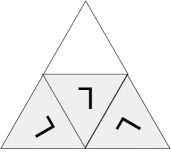 213 |
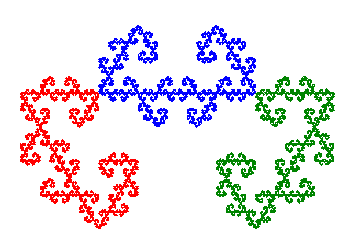 |
|||
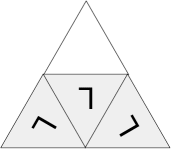 312 |
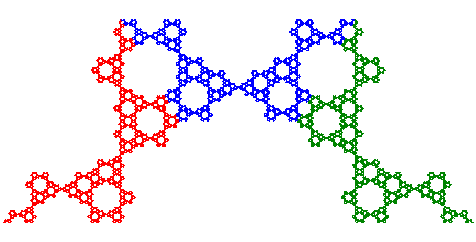 |
|||
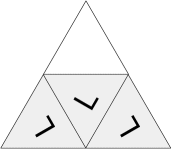 232 |
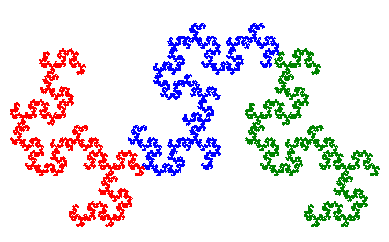 |
|||
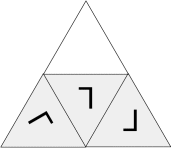 514 |
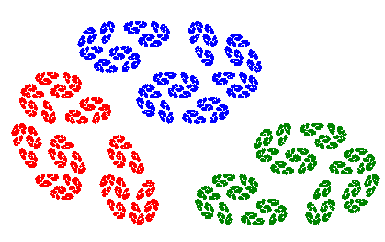 |
|||
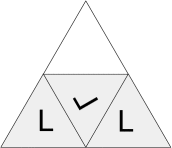 151 |
 |
In these examples, the fourth one is totally disconnected, the first and third one are connected no holes, and the second and fifth examples are connected with infinitely many holes just as with the Sierpinski gasket. There is also a fourth type that has infinitely many connected components.
Each triangle fractal can be described by a sequence of three digits corresponding to the transformations applied to each of the three triangles in the blueprint for that fractal. Because there are 6 possible transformations, there are 6x6x6 = 216 possible sequences. But different sequences might produce the same fractal.
Notice that fractal 111 above as well as example 1 (213) and example 2 (312) are all symmetric (with respect to a horizontal reflection across a vertical line). These are the only such symmetric triangle fractals. In addition, each of these 3 symmetric fractals can be formed from 8 different sequences of transformations. This accounts for a total of 24 sequences. The remaining 198 sequences produce fractals that are non-symmetric. They come in pairs, however, with the corresponding fractals symmetric to each other with respect to a horizontal reflection. For example, the picture below shows the fractals for the pair (512) and (316). Since these symmetric pairs are essentially the same fractal, the total number of triangle fractals is 3 + 96, or 99. [Counting Details].
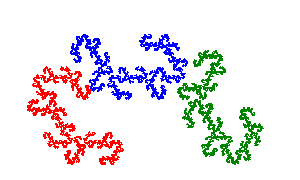
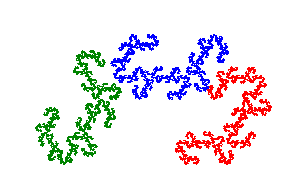
$$\sum\limits_{k = 1}^3 {{r^d}} = 1\quad \Rightarrow \quad d = \frac{{\log (1/3)}}{{\log (r)}} = \frac{{\log (1/3)}}{{\log (1/2)}} = \frac{{\log (3)}}{{\log (2)}} = 1.58496$$